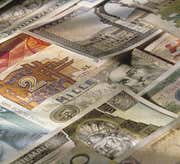
|
Finally, let's take a look at the Options table:
 |
Column 1: Strike Price. This is the stated price per share for which underlying stock may be purchased (for a call) or sold (for a put) by the option holder upon exercise of the option contract. When you exercise a call option, this is the value for which you purchase the shares. Option strike prices typically move in increments of $2.50 or $5. In the example above, the strike price moves in $2 increments.
Column 2: Expiry Date. This shows the end of the life of an options contract. Options expire on the third Friday of the expiry month.
Column 3: Call or Put. This column refers to whether the option is a call or a put. A call is the option to purchase, whereas a put is the option to sell.
Column 4: Volume. This indicates the total number of options contracts traded for the day. The total volume of all contracts is listed at the bottom of each table.
Column 5: Bid. The price someone is willing to pay for the options contract. To get the cost of one contract you need to multiply the price by 100.
Column 6: Ask. The price for which someone is willing to sell an options contract. To get the cost of one contract you need to multiply the price by 100.
Column 7: Open Interest. Open interest is the number of options contracts that are open. These are contracts that have not expired or have not been exercised.
Related Articles
-
 Trading
TradingA Newbie's Guide to Reading an Options Chain
Learning to understand the language of options chains will help you become a more effective options trader. -
 Trading
TradingBeginners Guide To Options Strategies
Find out four simple ways to profit from call and put options strategies. -
 Trading
TradingGetting acquainted with options trading
Learn about trading stock options, including some basic options trading terminology. -
 Trading
TradingOptions Hazards That Can Bruise Your Portfolio
Learn the top three risks and how they can affect you on either side of an options trade. -
 Trading
TradingA Quick Guide To Debt Options
Options on debt instruments provide an effective way for investors to manage interest rate exposure and benefit from price volatility, learn more today. -
 Investing
InvestingWhy Options Trading Is Not for the Faint of Heart
Trading options is not easy and should only be done under the guidance of a professional. -
 Investing
InvestingWhat are Options Contracts?
An explanation of options contracts, call options and put options.


